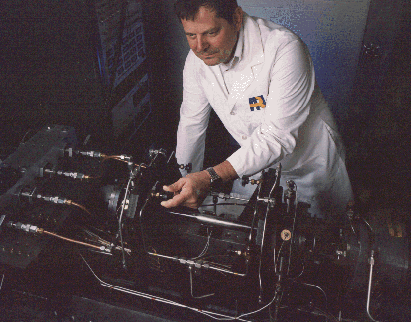 |
|||||
| Home | Research | For Teachers | HISTORY Level 1 Level 2 Level 3 |
PRINCIPLES Level 1 Level 2 Level 3 |
CAREER Level 1 Level 2 Level 3 |
| Gallery | Hot Links | What's New! | |||
| Web Administration and Tools | |||||
 |
|||||
| Home | Research | For Teachers | HISTORY Level 1 Level 2 Level 3 |
PRINCIPLES Level 1 Level 2 Level 3 |
CAREER Level 1 Level 2 Level 3 |
| Gallery | Hot Links | What's New! | |||
| Web Administration and Tools | |||||
![]()
Gas turbine shaft vibrations are conventionally suppressed with passive devices such as squeeze-film dampers. Recognizing the drawbacks of these dampers, bearings must be mounted on a flexible structure which can introduce reliability problems. The centerpiece of the Army/NASA Lewis program is active vibration control. Vibrations are sensed at one point on the engine and signals are fed back to piezoelectric actuators which move the bearing mounts in such a way as to suppress the vibrations. Applications include transmissions as well as turboshaft engines.
Computer simulations, backed by steady-state and transient demonstrations on in-house rigs, have shown that the vibrations in the T55, T63, and T700 engines can be controlled with piezoelectric actuators. Both synchronous and non-synchronous vibrations have been controlled, and it has been possible to shift critical speeds and remove them from the operating regime. Because the active approach allows controlling the rotor vibrations much more efficiently than a damper, the rotor can be self-balanced, and the stability limits can be eliminated with a feed forward controller. A range of conditions is being explored to extend the operating range of these actuators to higher temperatures and longer strokes. One such project is exploring different kinds of sensors and different locations of sensors to minimize seal wear. The long-range goal being to implement an expert-based digital control system that would control the engine vibrations with varying flight conditions and predict engine health.
Vibrations in transmissions generally relate to errors in gear-tooth meshing. These vibrations are transmitted by the shafting through the bearings to the case. The analysis is complicated by gear forces that cause nonlinear lateral and torsional coupling, gear-tooth passing frequencies, and gear-to-gear interactions over a wide bandwidth. Therefore, prediction techniques based on nonlinear analyses are being used in concert with the results obtained on a closed-loop gear test rig. Vibration and noise control have been demonstrated on two rigs at gear pass frequencies.
POC: Albert F. Kascak

Vibration Test Stand
![]()
Send all comments to ![]() aeromaster@eng.fiu.edu
aeromaster@eng.fiu.edu
© 1995-98 ALLSTAR Network. All rights reserved worldwide.
Updated: February 17, 1999